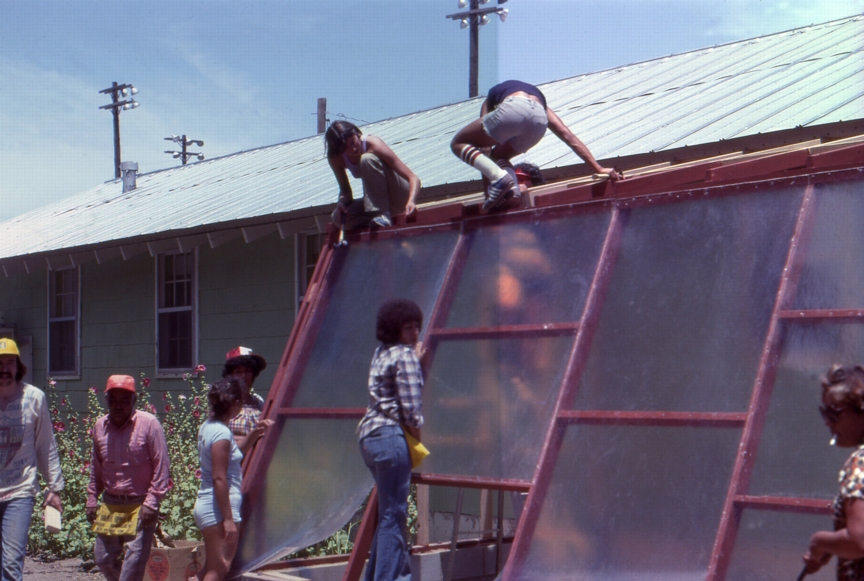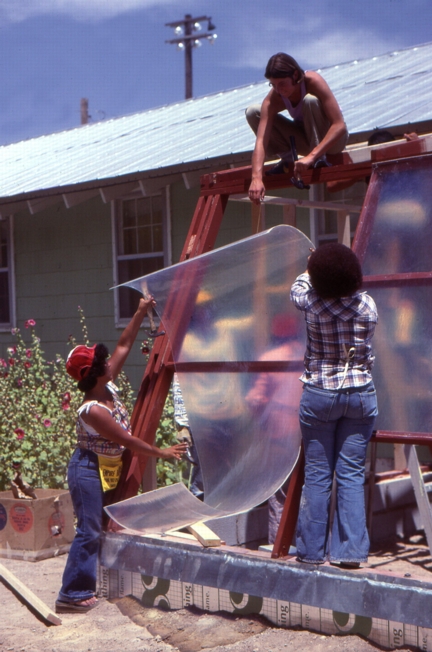In the UK these spaces used to be known as "conservatories" and were a common feature of homes of all classes. Nowadays they fall within the much wider scope of the term "home extension".
Blog Post
Sunspaces - Solar Heat and a Place to Grow Plants
Way back in the late 1970s, I worked for the New Mexico Solar Energy Association in Santa Fe. I ran the Workshop Program, leading a crew of three or four like-mined idealists teaching mostly low-income New Mexicans about solar energy through hands-on construction workshops. We primarily built attached solar greenhouses, or sunspaces--structures that provide not only passive solar heat to the adjoining house, but also a place to grow seedlings or house plants.
While I sometimes cringe to remember the poor quality of the sunspaces we were building in these community workshops--we used simple 2x4 frames and clad them with translucent fiberglass--those structures demonstrated the value of this passive solar heating system.
What is a sunspace? An attached solar greenhouse or sunspace (at least as I use the term) is a structure attached to the south side of a house that collects solar energy and transmits that heat into the home. From a technical standpoint, it's an "isolated-gain" passive solar heating system. Rather than solar energy directly entering the house through south-facing windows, the solar gain occurs in a structure that is thermally isolated from the house. Generally, "sunspace" refers to a structure that is used primarily as extra living space, while "attached solar greenhouse" refers to one whose primary function is for growing plants.
During the daytime in the winter, the sunspace heats up, and windows or vents between the sunspace and house can be opened to bring in solar heat. In most cases, these systems are "passive"--that is, they don't require pumps or fans to operate--though small fans are sometimes used to increase the heat flow. The beauty of this isolated-gain approach is that you can benefit from a large glazing area (i.e., lots of solar gain), but not have the penalty of all the heat loss through that glazing at night. The sunspace temperature is allowed to drop at night, but that doesn't result in discomfort in the house, because the windows or vents connecting the sunspace and house are closed.
By using insulated glass in a sunspace and providing some thermal mass (planting beds, brick cladding on the house wall, or water-filled drums painted black to absorb solar energy), a sunspace can be kept from freezing in all but the coldest, cloudiest climates. This is important if the sunspace is being used for growing plants.
When you don't want heat in the house (in the summer, for example), windows and vents between the sunspace and house are kept closed, while operable sunspace windows or vents to the outdoors are kept open. In a well-designed and properly managed sunspace, little if any heat from it enters the house in summer. In fact, because a south-facing sunspace shades the southern exposure of a house, it may actually keep the house cooler in the summer.
SUPPORT INDEPENDENT SUSTAINABILITY REPORTING
BuildingGreen relies on our premium members, not on advertisers. Help make our work possible.
See membership options »A place for plants vs. living space
In New Mexico, many of the attached solar greenhouses we built were used for extending the growing season in poor agricultural communities and Indian reservations. I remember how gratifying it was to see how beneficial such a structure was for a Hispanic subsistence farmer eking out a living by growing a few acres of chili peppers and pinto beans. With attached solar greenhouses, these farm families could grow, rather than buy, seedlings, and keep some vegetables growing year-round. And they would also reap the benefit of free solar heat, thus reducing the amount of wood or propane they needed to burn to keep warm.

When growing plants isn't as much of a priority, the economic arguments in favor of sunspaces aren't as strong, but in the right situation, such additions can still make sense. For a sunspace that is used primarily as living space and to add some supplemental heat to the house, glazing on the roof should be avoided and vertical south-facing glass usually makes more sense than sloped glazing (which we installed in those low-cost attached solar greenhouses in New Mexico). Vertical glass is much easier to install and maintain, and it will introduce less solar heat during the summer months (because the sun is higher in the sky and much of it reflects off the south-facing glass).
Sunspaces can be custom-built or bought pre-fabricated from companies like Four Seasons Sunrooms. To work effectively in reducing energy bills, sunspaces should be installed only on the south side of the house and should be configured so that they can be closed off at night. They can be used in other ways--sunlit living space on the east, west, or even north side or your house that's fully open to your living room, for example--but such an addition will most likely increase energy consumption rather than decreasing it.
In addition to this Energy Solutions blog, Alex contributes to the weekly blog BuildingGreen's Product of the Week, which profiles an interesting new green building product each week. You can sign up to receive notices of these blogs by e-mail--enter your e-mail address in the upper right corner of any blog page.
Alex is founder of BuildingGreen, Inc. and executive editor of Environmental Building News. To keep up with his latest articles and musings, you can sign up for his Twitter feed.
Published February 8, 2011 Permalink Citation
(2011, February 8). Sunspaces - Solar Heat and a Place to Grow Plants. Retrieved from https://www.buildinggreen.com/blog/sunspaces-solar-heat-and-place-grow-plants
Comments
there are a number of firms i
there are a number of firms in europe that have incorporated sunspaces (wintergardens) into their projects. i worked for a firm in freiburg (DE) that does this fairly regularly - pfeifer kuhn architekten. the resulting low-energy projects tend to require little insulation as well, and look pretty stunning. another firm utilizing similar strategies for low-energy projects is ingenhoven architekten (specifically the europaeische investitionsbank, luxembourg and lufthansa HQ, frankfurt)
from my experiences, integrating the sunspace/wintergarden into the building helped keep it compact and had the added benefit of bringing natural light deeper into the structure. works on institutional and commercial projects as well.




Add new comment
To post a comment, you need to register for a BuildingGreen Basic membership (free) or login to your existing profile.